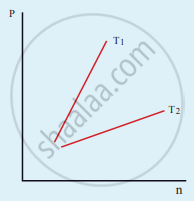Advertisements
Advertisements
प्रश्न
What is the microscopic origin of pressure?
उत्तर
According to the kinetic theory of gases, the pressure exerted by the molecules depends on
- Number density n = `"N"/"V"`
- Mass of the molecule
- Mean square speed
The pressure is given by P = `1/3 "nm"bar("v"^2)` or P = `1/3 "N"/"V" "m"bar("v"^2)`
APPEARS IN
संबंधित प्रश्न
A sample of an ideal gas is at equilibrium. Which of the following quantity is zero?
If the internal energy of an ideal gas U and volume V are doubled then the pressure ____________.
The following graph represents the pressure versus number density for an ideal gas at two different temperatures T1 and T2. The graph implies

Estimate the total number of air molecules in a room of a capacity of 25 m3 at a temperature of 27°C.
A perfect gas of 'N' molecules, each of mass 'm', moving with velocities 'C1', 'C2', ...... .'CN' is enclosed in a cubical vessel of volume 'V'. The pressure exerted by the gas on the walls of the vessel is ______. ('p' = density of gas)
The average force applied on the walls of a closed container depends as 'Tx', where 'T' is the temperature of an ideal gas. The value of 'x' is ______.
What is an ideal gas?
The kinetic energy per molecule of a gas at temperature T is ______.
Temperature remaining constant, if you double the number of molecules in a box, the pressure will ______.
The velocities of five molecules are 2 m/s, 3 m/s, 4 m/s, 5 m/s and 6 m/s. Find the root mean square velocity of molecules.
